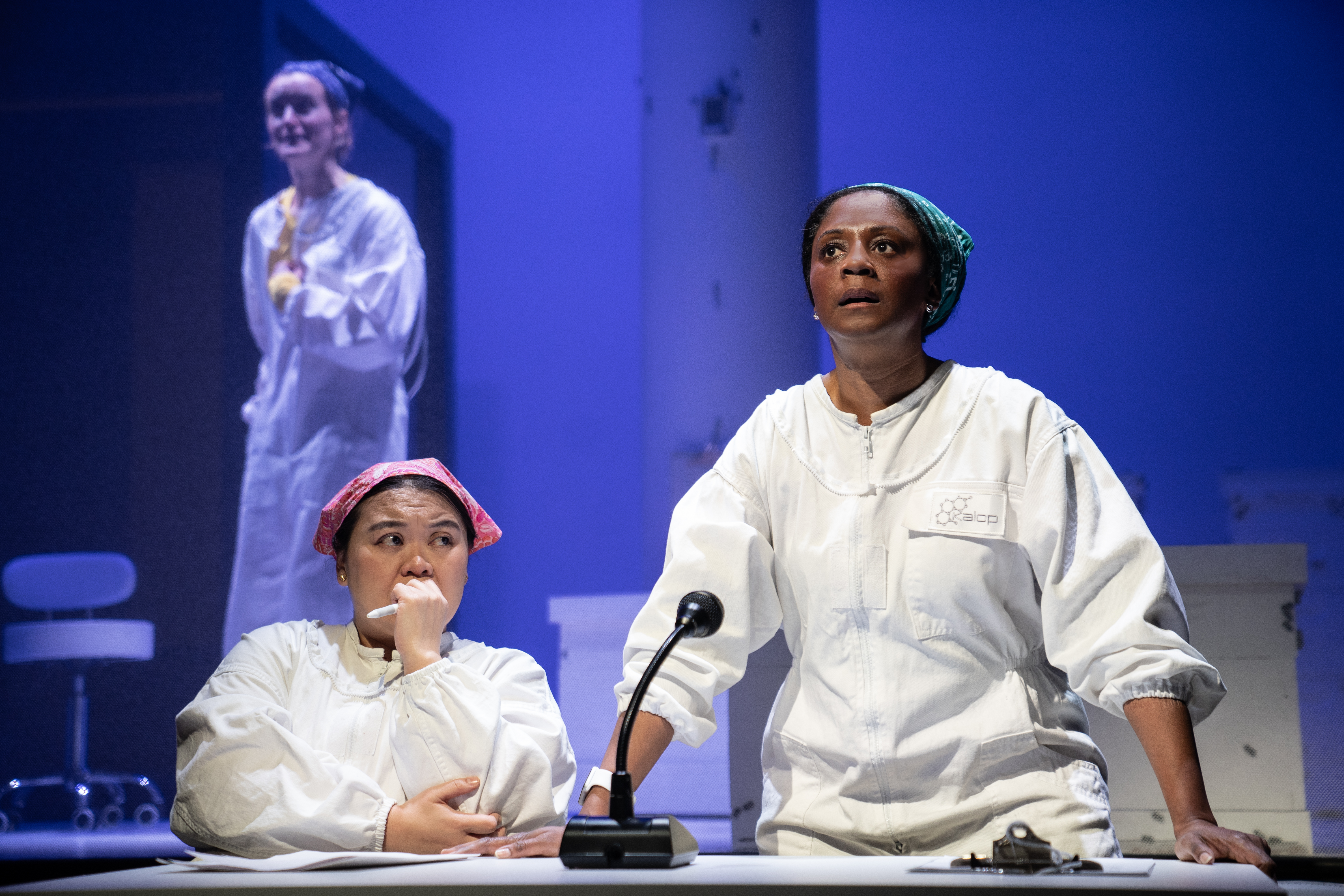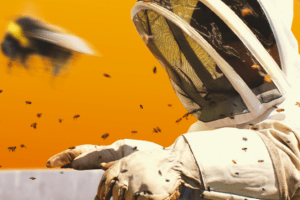Review: Kate Douglas’s The Apiary Begs Us to Consider the Bees
This new play has its debut at Second Stage Theatre.

(© Joan Marcus)
While you may be aware that bees are in danger of becoming extinct within our lifetimes–and of the drastic results this will have on our ecosystem–it’s likely not something you think about often. Kate Douglas, playwright of The Apiary at Second Stage, clearly thinks about bees a lot; her play is set 22 years in the future at a synthetic apiary that gives palliative care to bees, a species that has been almost entirely wiped out. Because of the lack of bees, there’s no honey, no almonds, no avocados, and almost no fruit. The characters work in an underfunded lab that attempts to keep bees hiving but is largely unsuccessful.
Douglas does fine work eschewing exposition and instead throws us right into the action as new employee Zora (April Matthis), an overqualified PhD, starts her first day. We meet the apiary’s rather intense lab manager, Gwen (Taylor Schilling), and the delightfully optimistic hive coordinator Pilar (Carmen M. Herlihy). Pilar and Zora bond over their love of bees, refusing to accept that their beloved insects will soon die out. When an unexpected event catalyzes the bees to start hiving again, Zora and Pilar take matters into their own hands, even though it means lying to Gwen and crossing several ethical and legal boundaries in the name of science.
The play explores a thorny issue that brings up emotionally compelling and relatable questions, from “What is our relationship to nature?” to “What are we willing to do to save an endangered species?” While these are fascinating, Douglas’s script, overall, leaves a bit to be desired. Every scene ends with a button, be it a rhetorical question, a cheesy joke, or cliffhanger, and they’re all clunky, which makes Kate Whoriskey’s production feel unnecessarily choppy. In the later half of this 70 minute, one act play, scene transitions are punctuated by short choreographic sequences where a dancer (Stephanie Crousillat) in a gas mask does jerky interpretive dances representing the bees–an odd choice which stylistically does not match the otherwise naturalistic approach of Whoriskey’s direction.
From an acting perspective, Herlihy is the guiding light of the production. During a preshow she processes bee carcasses while casually lip syncing to 2000s pop; it’s hard not to be enamored right away. As she trains the more formal and driven Zora, she always has a smile on her face, earnest to the core. Matthis finds a quieter, more measured approach, letting her researcher brain and passion guide her arc. Schilling takes the biggest swing. Her Gwen is always at a 10, speaking in an almost monotone yell, treating everything as an imperative. While I can see where she is coming from, I was not always convinced by this choice, which makes Gwen feel far less real than all the others.
Rounding out the cast is Nimene Wureh as several characters, all of whom volunteer to help Zora and Pilar with the bees. Each has a deep emotional connection to bees (often from family history) and to the environment–connections that Zora and Pilar share and admire. One of Wureh’s characters monologues about how her mother, who raised bees, told her of the importance of talking to the bees, telling them about all the important events going on. It can seem silly, sure, but as the play goes on, we begin to question whether this more personal technique can be even more impactful than the more distant and sterile approach of the scientific method with its testing of hypotheses and clinical trials.
Walt Spangler’s set covers the stage in a gauze net, transparent enough to see through, but visible enough to effectively separate the audience from the laboratory space. From within the lab, we can see bees clustered along the net and walls and piled in an orange cube called “the graveyard” (which doubles as a sort of stage and cage for the dancer). The costumes by Jennifer Moeller consist primarily of the iconic and recognizable all-white beekeeping suits, which match the stacked white hive boxes. Likewise, the space is mostly white with a clinical air, but the ancillary lab spaces on the side of the stage feature hints of black and yellow.
The Apiary encourages us to consider the bees, their plight, our human complicity, what a world without bees might mean, and what the most effective means to saving them might be. Douglas suggests that perhaps that just might be through a piece of theater — but it doesn’t work as well as she’d hoped.









